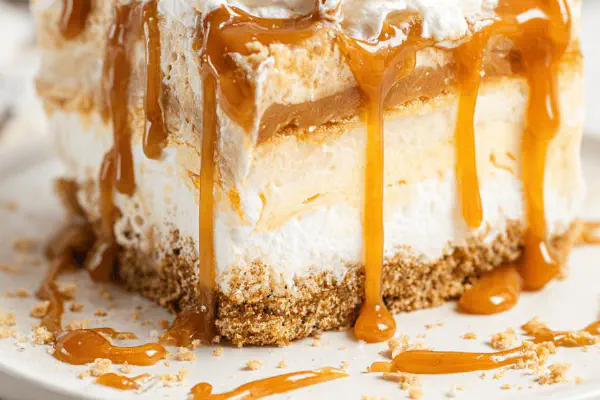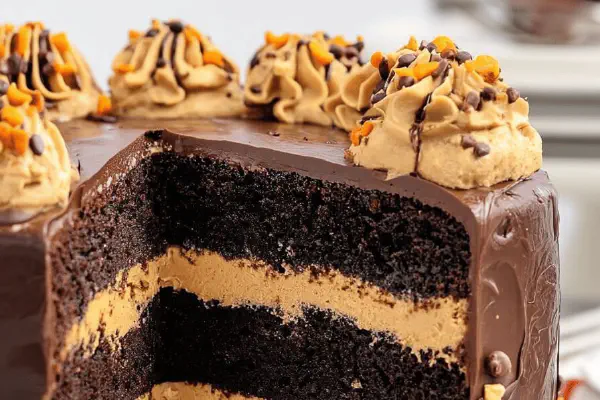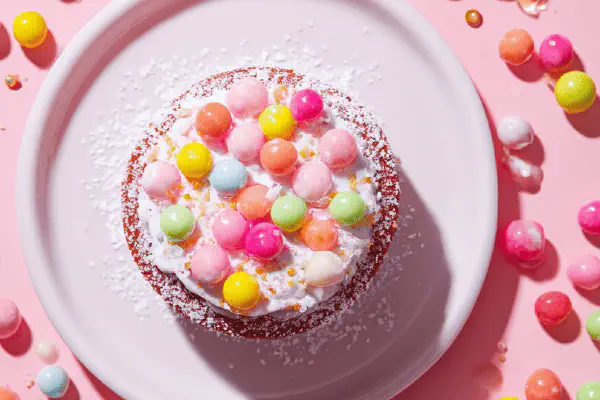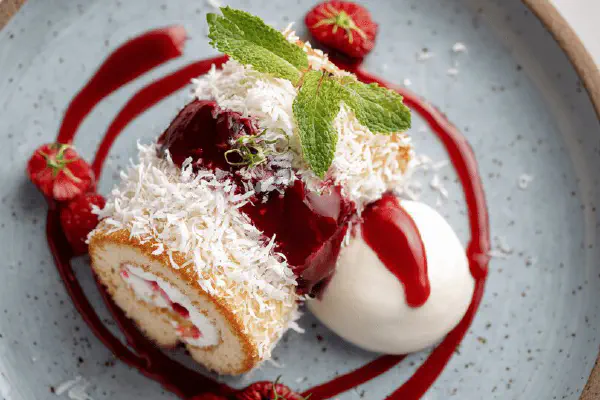Sugar Pie in Jars
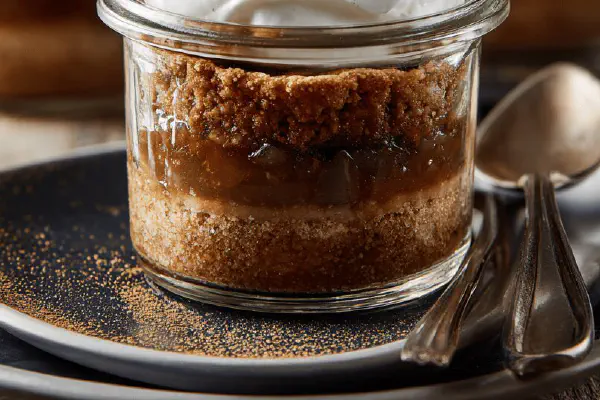
By Emma
Certified Culinary Professional
Ingredients
Crust
- 475 ml unbleached all-purpose flour (2 cups minus 1 tbsp)
- 50 ml sugar (about 3 tbsp plus 1 tsp)
- 2 ml salt (just under ½ tsp)
- 240 ml cold unsalted butter, cubed (just shy of 1 cup)
- 20 ml milk (1 tbsp plus 1 tsp)
- 1 egg
Filling
- 460 ml packed brown sugar (1 7⁄8 cups)
- 70 ml cornstarch (about 5 tbsp)
- 475 ml 35% cream (2 cups minus 2 tbsp)
- 230 ml maple syrup (just under 1 cup)
- 2 large egg yolks, lightly beaten
- 1 whole large egg, lightly beaten
Whipped Cream
- 375 ml 35% cream (1 ½ cups)
- 80 ml sugar (slightly less than ½ cup)
About the ingredients
Method
Crust
- 1. Pulse flour, sugar, salt in food processor briefly. Add butter cubes; pulse until pieces resemble small peas. Butter temperature matters — too soft ruins flakiness. Cold is king. Add milk and egg. Pulse quickly until dough clusters. Watch closely; too much mixing toughens crust. Form into a disc; wrap and chill 30 minutes minimum. This rests the gluten; neglect this and crust shrinks during bake.
- 2. Flour surface lightly. Roll out dough to 3 mm thickness (about 1/8 inch). Cut 36 rounds, each 6 cm in diameter. I like using biscuit cutter or glass rim; sharper edges give cleaner crust shapes. Arrange on parchment-lined pan. Cover loosely, refrigerate another 25 minutes — chilling is key for less spreading and better browning.
- 3. Preheat oven to 205°C (400°F). Position rack low to help bottom crusts cook fully without overbrowning tops.
- 4. Bake rounds 12-17 minutes. Watch for golden color edges and puffing. Too pale—dough underbaked, too dark—burnt butter notes ruin delicate feeling. Cool completely before assembly. Hot crusts melt filling prematurely.
Filling
- 5. In heavy saucepan, whisk brown sugar with cornstarch. Add cream, maple syrup, yolks, egg whole. Stir well to avoid lumps. Medium heat essential — low heats slow caramelization, high risks scrambling eggs or lumps. Stir continuously. After 8-12 minutes, thick mixture should bubble gently and coat spoon thickly. Should cling but still be pourable. Remove from heat immediately — carryover heat continues thickening.
- 6. Transfer filling to bowl. Cover surface tightly with plastic wrap to prevent skin formation. Chill until lukewarm or cool — at least an hour. Cooling stabilizes custard, improves texture. Resist temptation to rush.
Whipped Cream
- 7. Beat chilled cream with sugar until stiff peaks form. No over-beating; cream graininess kills mouthfeel. Keep bowl and beaters cold for best volume. Sugar slows whipping but adds stability and sweetness.
Assemble
- 8. Into twelve 250 ml jars or glasses, place one crust disk bottom. Spoon custard evenly atop. Top custard with second crust disk, then a generous dollop of whipped cream. Add final crust disk as lid. This triple layer is classic but optional. The top crust seals cream, adding texture contrast against smooth filling and soft whipped cream.
- 9. Seal jars with lids. Chill for at least 2 hours. Flavors meld. Filling firms slightly, crusts soften just enough but remain crisp. If unsealed glasses used, cover with plastic wrap. Avoid condensation.
- 10. Serve cold straight from fridge. Garnish with a pinch of cinnamon or finely chopped crystallized ginger for a spicy twist. Leftovers keep refrigerated up to 3 days. Crust softens but flavor remains rich.
Tips & Substitutions
- Butter can be replaced with cold shortening for less flavor but flakier crust; I prefer butter for taste. Use honey instead of maple syrup if you don’t have it, adjusting sweetness. If no cornstarch, arrowroot or tapioca starch work but thicken differently; watch textures.
- If dough sticks too much rolling, chill extra 10 minutes. Avoid overhandling.
- If filling splits, whisk gently and reheat low with a little cream to fix.
- Visual cues over timers; every oven and cream varies. Custard ready when thick and bubbles—not boiling violently but gently simmering. Crust ready when golden edges and springy to touch. Whipped cream stiff but not dry.
- This pie is forgiving but requires patience. Don’t skip chilling steps, or textures suffer.
Cooking tips
Chef's notes
- 💡 Butter must stay cold—too soft and dough won’t form flakes. Pulse flour and butter short bursts; pea size bits. Longer means greasy crust. Chilling dough twice relaxes gluten, prevents shrinking. Watch mixing speed; quick pulses only once liquids go in. Dough sticky? Chill longer. Rolling thin? Beware brittle edges. Dough temp dictates results more than oven time.
- 💡 Brown sugar packed but not crushed. Cornstarch key thickener; arrowroot or tapioca swap but differ texture. Whisk filling constantly mid heat—too hot scrambles yolks, too low delays thickening. Mixture bubbles softly when ready. Remove from heat immediately; residual heat thickens more. Cover custard tightly with plastic to avoid skin. Cooling phases crucial; patience pays off. Don’t rush steps or texture poofs.
- 💡 Using jars means layering crusts and filling carefully. Crust disks crisp then soften slightly in fridge but avoid soggy. Triple crust layer seals cream well but optional if top crust intimidates. Bake crusts golden, edges springy. Hot crusts melt filling early; cool fully before assembly. Chilling jars for hours lets flavors blend, gently firm filling. Containers seal aromas too, keeps freshness longer.
- 💡 Whip cream cold bowl and beaters. Sugar slows whipping, adds stability and sweetness; add gradually. Stop at stiff peaks; over-whipped cream turns grainy, butterish. Fresh cream whips better; older cream can fail. Whipped topping balances dense custard—adds airy contrast. Use immediately or chill with plastic cover to prevent drying.
- 💡 Oven rack position matters; low rack cooks crust bottom fully without darkening tops. Watch crust edges color, slight spring when pressed. Baking times vary; visual and tactile cues override timers. Custard thick when coating spoon thickly but pourable. Filling’s texture soft, smooth gloss signals doneness. Chilling time varies too; lukewarm custard better than hot. Balance all phases for layered textures.
Common questions
How to prevent crust shrinkage?
Chill dough twice. First rest tightens gluten. Roll dough evenly but not too thin. Use cold butter, avoid overmixing. Rest crusts in fridge again after cutting. Dough temp matters more than time. Handles help.
What if custard lumps form?
Whisk vigorously while cooking. Medium heat only; high scorches or scrambles. If split, reheat gently with splash cream and stir slow. Use fine strainer to fix texture if needed. Stir slow but steady. Watch closely.
Can maple syrup be swapped?
Honey works but changes flavor profile and sweetness level. Adjust sugar down or up. Corn syrup or molasses more intense, less sweet—use sparingly. Syrup choice affects custard depth, caramelization speed. Test small batches first.
How to store leftovers?
Keep jars sealed in fridge up to three days. Crust softens slowly but flavor lingers. If unsealed glass, cover tight with plastic wrap to avoid moisture. Freeze not ideal; custard texture degrades. Serve cold, allow slight warming if overly firm.
